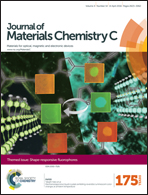Fluorescence behavior of 5,10-disubstituted [5]helicene derivatives in solution and the effect of self-assembly on their radiative and non-radiative rate constants†
Abstract
The surrounding environment of a molecular fluorophore is one of the most important determining factors in luminescence properties, such as the emission quantum yield, the lifetime of the excited state, and the color of luminescence. In this work, we investigate the relationship between the self-assembled structure and the fluorescence properties of [5]helicene derivatives in the solution phase. A [5]Helicene derivative bearing the tri(ethylene glycol) group formed spherical aggregates in aqueous media and that bearing the (3,4,5-trioctyloxyphenyl)carbamoyl group formed fibrous aggregates in apolar solvent. Analysis based on the radiative (kf) and non-radiative (knr) rate constants suggests that (1) an aggregation-induced suppression of fluorescence observed in aqueous media is attributed to the decrease of kf, (2) an aggregation-induced enhancement of fluorescence observed for fibrous aggregates formed in an apolar solvent is associated with the suppression of knr, (3) [5]helicenes become almost non-fluorescent especially in a polar solvent by introducing an appropriate donor substituent due to a charge-transfer (CT) type property in the lowest energy excited state, and (4) the strong quenching effect due to the CT-type excitation can be efficiently alleviated by several approaches, such as by forming aggregates with an appropriate self-assembly motif or by controlling the energy level of molecular orbitals.
![Graphical abstract: Fluorescence behavior of 5,10-disubstituted [5]helicene derivatives in solution and the effect of self-assembly on their radiative and non-radiative rate constants](/is/Image/Get?imageInfo.ImageType=GA&imageInfo.ImageIdentifier.ManuscriptID=C5TC03675E&imageInfo.ImageIdentifier.Year=2016)
- This article is part of the themed collections: 2016 Journal of Materials Chemistry C Hot Papers and Shape-Responsive Fluorophores

 Please wait while we load your content...
Please wait while we load your content...